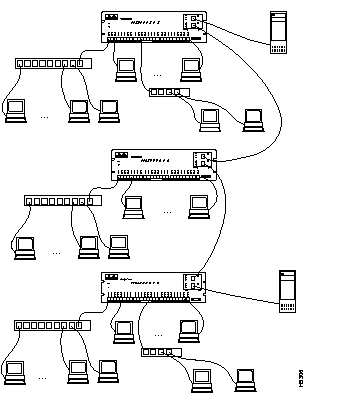|
|

This chapter describes the cabling requirements and other preinstallation guidelines for installing a Catalyst 2100. Also included are several sample configurations.
You can install your Catalyst 2100 in the same locations as your other Ethernet hubs, bridges and routers. This would normally be a wiring closet but it could also be an office.
The Catalyst 2100 can be mounted on a table, shelf, or rack. The key requirement is that Catalyst 2100 be located within 100 meters of its attached devices. As the LEDs and the cable connectors are on the front panel, you should ensure easy access to the front of the switch. Avoid routing the UTP cabling used to connect to Catalyst 2100 ports near power lines, fluorescent lights, or other sources of electrical noise.
Catalyst 2100 is compatible with the IEEE 802.3 CSMA/CD media access control layer and frame format. It therefore supports existing network management software and diagnostic tools.
The 10Base-T ports are compatible with the IEEE 802.3 10Base-T standard and connect to individual workstations, 10Base-T hubs, or other 10Base-T compatible devices.
The 100Base-TX ports are compatible with the IEEE 802.3u 100Base-TX specification and connect to 100Base-TX servers, hubs, backbone switches, and routers.
Each type of Catalyst 2100 port has its own cabling guidelines. These include the kinds of devices you can connect to the ports and the length and type of wiring you can use.
The 25 10Base-T ports require Category 3, 4, or 5 UTP wiring. Attached devices must be within 100 meters of the Catalyst 2100 and be 10Base-T compatible.
The AUI connector on port 25 connects to an external thick coax, thin coax, or fiber optic transceiver. Supported network and device distances will vary depending on the type of transceiver used. Only one port 25 connector, either RJ-45 or AUI, can be used at a time.
The two 100Base-TX ports require Category 5 UTP cabling. Attached devices must be within 100 meters of the port and be 100Base-TX compatible.
This section describes several situations where Catalyst 2100 can best be put to use. The following are the sample configurations:
Catalyst 2100 supports 25 switched Ethernet connections for single workstations, multiple workstations for a single user, or 10Base-T hubs, and two 100Base-TX ports for server and backbone connectivity.

Multiple Catalyst 2100s can be daisy-chained via CollisionFree 100Base-T for up to 200 Mbps bandwidth between switches. Additional high-speed ports can be used to connect to 100Base-T servers or other devices.

Catalyst 2100s can connect to a 100Base-TX backbone switch or router. With support for CollisionFree full-duplex operation, each 100Base-TX link supports up to 200 Mbps of bandwidth.

Catalyst 2100s can connect to a 100Base-T backbone switch or router in a redundant backbone configuration using the Spanning-Tree Protocol. With support for CollisionFree operation, each 100Base-T link supports up to 200 Mbps of bandwidth.

|
|